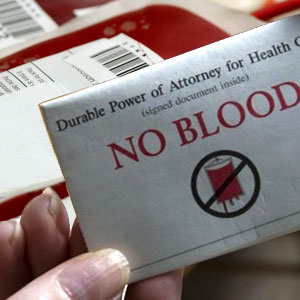後藤さんのブログで触れられていた臨床試験の諮問の件で「曖昧な箇所があるならばシニアに助言をこうなりガイドラインを確認するなりする」というキーポイントが触れられていたのを読み、丁度MMIの例題で関連性のあるケースにあたっのいたでその件について。
4. An eighteen year-old female arrives in the emergency room with a profound nosebleed. You are the physician, and you have stopped the bleeding. She is now in a coma from blood loss and will die without a transfusion. A nurse finds a recent signed card from Jehovah’s Witnesses Church in the patient’s purse refusing blood transfusions under any circumstance. What would you do?
(18歳の女性がひどい鼻血を出して救急外来に。あなたは医師で、止血した。患者の意識はなく輸血をしないと死んでしまう。看護師がエホバの証人の信者でどんな場合でも輸血拒否の意思表示を示すカードを見つけた。あなたはどうしますか。)
ポイントは年齢が自己に関する意思表示が単独でできる年齢であるかどうかと、
意識があるかどうか、なければ輸血に関する同意のカードがあるかどうかでしょうか。ローカルのガバメントのサイトを調べてみると、基本輸血するには同意が必要で、意識がない場合や未成年である特別なケースのときには、親権者や本人の医師を代弁する近親者が代理で同意に応じるとガイドラインにある。
エホバの証人の信者の方のケースは特別に注意が必要であり、というのも信者の中には完全拒否の人と特定の血液の成分の輸血には応じる人もいるからで、その詳細が輸血同意確認カードに記されていることもあるからその確認は大変重要なようです。
さらにガイドラインにはエホバの証人の専用のガバメントの電話番号が記載されてありますので、微妙なケースの場合のアドバイスを乞うことができるのかも知れません。
本人の意思が確認できないのだから、とりあえず人命救助が最優先で同意なしに輸血を決定するということは意思表示のカードでのNoがある限りできなさそうです。ガイドラインによると代替手段を試みるべしと書いてあります。
学部入試のインタビューでは 具体的な代替手段を知っていることまでは求められていないと考えられるので、この場合は、
- · 同意確認書に血液成分の輸血の許可が書かれていないか確認する。
- · シニアに連絡を取って取るべき代替手段を確認する。
- · ガイドラインを確認する。
- · 医師へのヘルプラインがあれば連絡をとって指示を仰ぐ。
- · 近親者本人の意思確認ができる人と話す。カードにあるサインは本当に本人のものかも含めて患者さんの意思を知っているかどうかの確認。
などをして、輸血を施さずにどこまでできるかを模索し自分の確信を持ってできる範囲を超えずにガイドラインとシニアの指示にしたがいますと答えようかと思いました。後藤さんをも触れられていたように、自分の職分と能力で余るときには外部の助言を仰ぐというのがこの場での対応かなと。
大学でもたまにPatient Centred Care という単語に出会いますが、オーストラリアでは医療を受ける際には本人の意思が尊重されるので同意がなければ医療側は全く動けない印象。死んでしまうかも知れない人を前に輸血をしない決断を下すのはとてもストレスフルだと思いますが。
英語で書いてみます。変な表現、意味の取れない箇所があればご指摘お願いします。
To achieve patient centred care, it is essential to get consent from the patient for a blood transfusion from the patient. Patients have to sign the form to refuse or accept the treatment to absolve medical staff from liability from a failure to administer the blood. This is the case for an adult Jehovah’s Witness patients who cannot give consent or refusal for a blood transfusion.
As patient carrying Medical Directive Card, I assume that the patient’s directive is disapproval for blood transfusion. To confirm the refusal, I will first try to talk with the person who can be mandated by the patients to the consent or dissent, such as her partner if possible. After that, I try to find out the unwillingness for blood transfusion means whole blood transfusion or partial blood component and seek the possibility for partial blood component transfusion by checking the card and talking the next of kin. If any blood transfusion is refused, I will find the advice from a senior doctor alternative treatment for this case. Getting back to the blood transfusion treatment guideline is also essential when it comes to exceptional cases. If no other senior doctor is available to seek the advice, I will call the helpline for the Jehovah’s Witnesses Patients.
If any ambiguous case, I will seek the advice for the situation from senior doctors, the local guideline, or helpline for this particular case to make a treatment plan. Knowing the limitation of my ability and seeking appropriate help will result in the safer practice for both patients and medical staffs.
参考
NSW South Eastern Health District, Clinical Business Rule
<http://www.seslhd.health.nsw.gov.au/rhw/manuals/documents/Blood%20and%20blood%20products/Blood%20Component%20Management%20and%20Administration.pdf>
















Koalaさん、
臨床の現場でエホバの証人の信者さんに出会ったことはありません。それでも、これに類似する問題は日常的に目の当たりにします。
例えば、煙草を止めない患者さん。患者さんは、「これは私の体だから、タバコを吸う・吸わないのは自分の勝手」と言います。自分の体をどうするか?それは確かに、最終的に個人の判断にゆだねられます。その判断がたとえその人の健康や寿命に害を与えると分かっていても、医者は患者さんの意思に反して治療を施すことが出来ません。
目の前でゆっくりと自殺することを選択する患者さんを見ながら、何もできない自分の無力さとどう向き合うか。これは、特に総合医 General Practioner が日々直面する問題だと思います。
Patient Education の一環としてタバコの害のエビデンスを示すこともできると思いますが.。最終的な決断は本人次第ですしね。あなたのいうことなら聞いてみようか、というくらいの普段から積み上げた信頼関係があれば少しは違うんでしょうか。子育てにも通じる悩ましい問題だと感じます。
The following is my feedback to your answers.
>>Good
* Appropriate vocabulary
* Sound logic
* relevant knowledge
>>Where you can improve
* Keep it simple and conversational (if this is an interview)
* Start with one sentence just describing your goal. (e.g. Firstly, I would place my utmost priority on the patient-centred care.)
* Then move on how you would achieve your goal.
>> Need to know
What interviewers are trying to assess is whether you have an ability to deal with the unknown situation.So, to do well with this kind of the interview, you first need to demonstrate you have a simple goal, and then show how you can appropriately achieve that goal.
>> My last advice
KEEP IT SIMPLE! They don’t expect you to solve the problem.
>> My approach
“I would place my utmost priority on the patient-centred care. To this end, I believe there are five things that need and can be done. First, I would strive to obtain a verbal consent from patient herself. If this fails, then it leads me to the second step, which is to check if the patient has expressed in writing against the blood transfusion……. Third, check whether patient had a capacity to sign the card…. Fourth, family consent or enduring power of attorney …. Lastly, I would seek help from senior doctors, guideline and helpline.”
So, true. Your work is nice and straightforward. I try to get out from self-complicated habit for clear communication. Thank you so much for the kind advice.